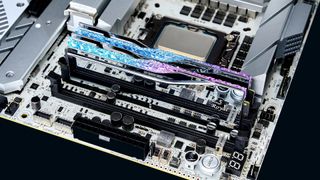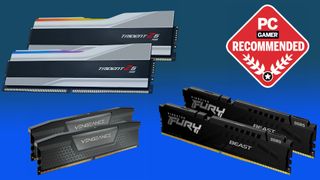G.SKILL and Kingston break the 12,000MT/s DDR5 memory barrier with Intel's new Arrow Lake CPU
Theoretically bananas bandwidth, but not terribly practical for gaming.

Intel's new Core Ultra 200S chips, otherwise known as Arrow Lake, officially support DDR5-6400 RAM. But the memory specialists at G.SKILL and Kingston have been overclocking the twangers off some fancy new DDR5 DIMMs. The result? Speeds not far off twice as fast as both memory vendors have blasted through the DDR5-12000 barrier.
We'll come back to how relevant any of this is in a moment. But for the record, G.SKILL is claiming 12,066MT/s while Kingston reckons it has done a tiny bit better at 12,108MT/s.
In part these figures are possible thanks to the use of the latest CU-DIMM memory tech. CU-DIMM memory sticks sport a dedicated clock driver. The idea is to reduce the CPU's role in memory clock synchronization and in turn improve stability and enable higher memory frequencies.
Inevitably, there are numerous caveats to all this. For instance, Kingston's result was not only achieved courtesy of liquid nitrogen cooling for the DDR5 sticks. It also entailed running the Core Ultra 7 265KF CPU with its E cores disabled and the P cores running at just 400MHz.
In other words, any even notional performance gains from the sky high DDR5 frequencies will have been thoroughly kiboshed by the feeble CPU clock. Even then, you're not going to get much uptime when running on liquid nitrogen cooling.
But let's pretend, just for a moment, that you could hit DDR5-12000 at full CPU clocks and without exotic cooling. How much difference would that actually make?
As it happens, Nick recently took a look at Arrow Lake gaming performance using various memory speeds. He found that the jump from the official DDR5-6400 to DDR-8200 netted an increase from 103fps to 109fps in Cyberpunk 2077 at 1080p, so just over 5%.
The biggest gaming news, reviews and hardware deals
Keep up to date with the most important stories and the best deals, as picked by the PC Gamer team.
Baldur's Gate 3 shows even better results, with a 10% gain in average frame rates at 1080p going from DDR5-6400 to DDR-8200. However, Homeworld 3 and Total War: Warhammer III showed more modest gains, adding just one FPS and two FPS respectively.
What you make of those kinds of gains is subjective. On the one hand, you're going to struggle to feel the benefit in the real world. On the other, 10% is a pretty hefty jump when you consider how modest the gaming performance gains have been from the latest CPUs from both AMD with Zen 5 and Intel's Arrow Lake.

Best RAM for gaming: the latest and greatest
AMD's new Ryzen 9000 chips are only slightly faster when it comes to gaming than their Ryzen 7000 predecessors, while Intel's new Core Ultra 200S CPUs are actually a bit slower for games than their outgoing 14th Gen Raptor Lake equivalents. So, any additional performance gains from fast memory are welcome.
That said, one can't just assume that adding yet more memory frequency will result in proportionally higher frame rates. But you would expect at least a little more performance. So, DDR-12000 would likely help Arrow Lake look a little less disappointing in the gaming stakes.
Of course, it's a thoroughly academic consideration given that there's no practical way to actually game with memory running at 12,000MT/s. But it's a big old number and it helps keeps things moving in the right direction. It's just worth being realistic about the likely rewards before you spend hard on some fancy DDR5.

Jeremy has been writing about technology and PCs since the 90nm Netburst era (Google it!) and enjoys nothing more than a serious dissertation on the finer points of monitor input lag and overshoot followed by a forensic examination of advanced lithography. Or maybe he just likes machines that go “ping!” He also has a thing for tennis and cars.
Most Popular







